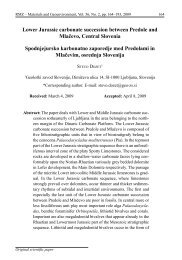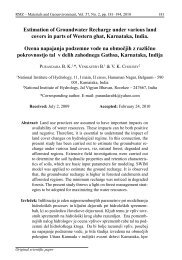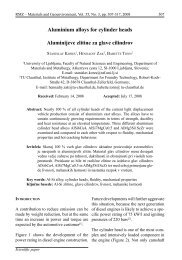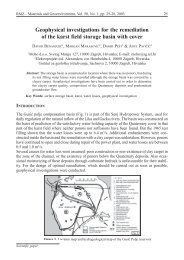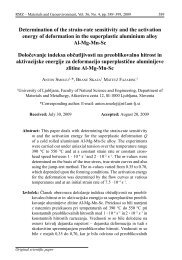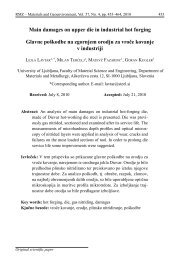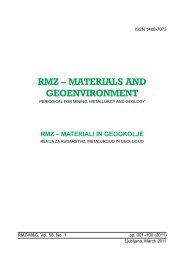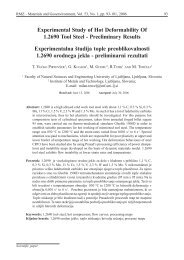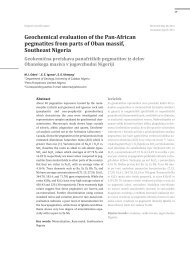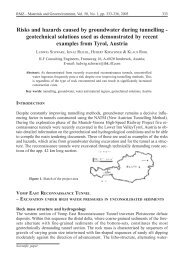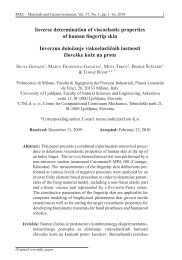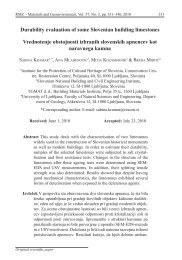RMZ â MATERIALI IN GEOOKOLJE
RMZ â MATERIALI IN GEOOKOLJE
RMZ â MATERIALI IN GEOOKOLJE
- No tags were found...
You also want an ePaper? Increase the reach of your titles
YUMPU automatically turns print PDFs into web optimized ePapers that Google loves.
The groundwater potential evaluation at industrial estate Ogbomoso, ...ρLAWeathered Layer Transverse Resistance2πrMap2Aquifer transmissivity has been foundto ∆Vbe = a ∫ Every . dr.powerful means of confirmingzones of prolific aquifers. Thisparameter Iρis defined in hydrogeology,∆V=as the 2product πrof aquifers hydraulicconductivity (or permeability) and itsthickness. ρ = ∆V.2πrT = K × h (10)where ∆T Vρ is transmissivity, K is hydraulicconductivity I and h is the thicknessa= . Gof the aquifer (Todd, 1980).AB 2 MN 2π (( ) − ( ) )According G = 2to Maillet, 2 1974 transverseresistance (R T)MN2( of a ) layer as of the Dar-Zarrouk parameters, 2 is defined as:R T= h × ρ (11)Where, ρ1> ρ2h < and ρ3ρ are thickness and resistivityrespectively, of the layer.ρ1< ρ2> ρ3< ρ4The relationship between transmissivity(T) and transverse resistance (R T) isn−1n−1meaningful, simply becausehi∑ hhydraulicconductivity ρti=1 (K) and i=1 resistivity ρiλ = =(ρ)iρi∑n−1have a ρdirect l linear relationship 2 (Niwas)& Singhal, 1981).(∑ hiCombining the twoi=1equations, we haveKT = × RT = Kσ× R T (12)ρThis relationship is suitable for determinationof aquifer transmissivity,as the ratio K/ρ = Kσ is assumed tobe constant in areas with similar geologicsetting and water quality (Niwas& Singhal, 1981; Aderinto, 1986;Onuoha & Mbazi, 1988; Onu, 2003).<strong>RMZ</strong>-M&G 2012, 59381Thus knowing the value of K for someexisting boreholes and the value of σextracted from the sounding interpretationfor the aquifers at the boreholelocations, the transmissivity of the aquifercan be computed.These established relationships wereutilized with the hydraulic conductivity(K) values of boreholes near Northwesternside (i.e. some metres awayfrom VES 10), near Northeastern side(i. e. some metres away from VES 9),and the other two boreholes were locatedtowards the Southern part of thestudy area (i. e. behind the Civil defenceoffice). The hydraulic conductivity(K) were determined to be (6.62,11.99, 11.42 and 15.54) m/d respectivelyafter pumping test by D’ StrataDrilling Company and the Kσ of thesepoints were found to be 0.097, 0.097,0.1164 and 0.1034 respectively. Anaverage of 0.10344 was used for theentire study area. The transmissivityat each VES station was determinedby multiplying average Kσ with correspondingtransverse resistance, R Tandthe variation of transmissivity acrossthe aquiferous zone of the investigatedarea is shown in figure 8.On a purely empirical basis, it can beadmitted that the transmissivity of anaquifer is directly proportional to itstransverse resistance (Henriet, 1975).Therefore, transverse resistance mapsis used in determination of zones with



